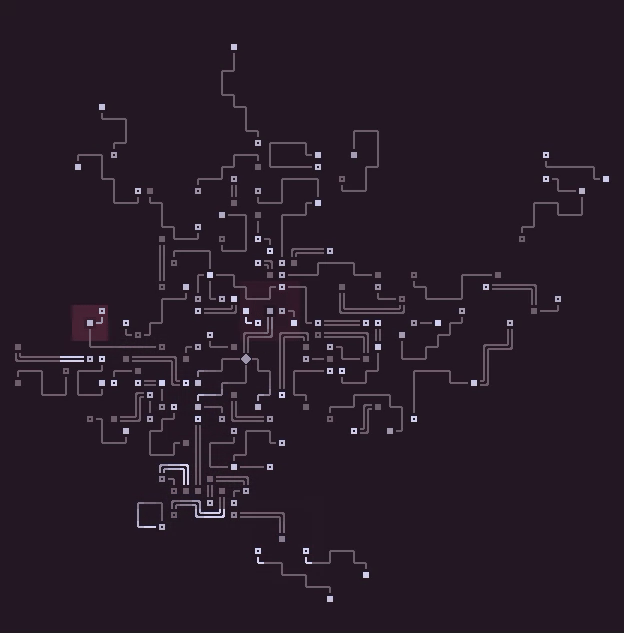A small frontend library for creating and rendering cellular automatons using ASCII graphics.
The current features of ascii-cell include:
- Growable and shrinkable grid of cells.
- Consistent cell updates: changes will not affect other cells during a simulation step.
- Efficient pixel font rendering.
- Visual effects that can modify the way cells are rendered.
- Minimal renders: only the cells that have changed are re-rendered.
- Cells can put themselves to sleep, and groups of sleeping cells are not processed or re-rendered.
You can install ascii-cell using npm or yarn:
npm install ascii-cell
# ...or...
yarn add ascii-cellWith this method, it's recommended to directly import the different submodules, so that only the relevant code is added to your bundle:
import Simulation from "ascii-cell/simulation";
function MyComponent() {
const sim = new Simulation({
// Your simulation settings
});
// ...
}For Typescript, you will need to have compilerOptions.module >= "node16" in your tsconfig.json for the submodules to be available this way,
as they are relying on the exports field in this library's package.json.
If you wish to use this library without npm, then you can import it from a CDN, like so:
import { Simulation } from "https://cdn.jsdelivr.net/npm/ascii-cell@0.1.0/dist/simulation.js";The easiest way to make your own cellular automaton is to clone this repository and run the included examples/ folder:
# You only need to run the following commands once:
git clone https://github.com/adri326/ascii-cell/
cd ascii-cell
npm i
# Whenever you want to run the examples:
npm run devThen, either change examples/gol-simulation.ts to implement your own cellular automaton, or copy it to a new file and tweak examples/preview.tsx to point to your new file.
I strongly recommend having a typescript language server to ensure that your cellular automaton is type-checked while you work.
Cellular automatons with ascii-cell are defined as one big object, that looks like this:
import type { SimulationOptions, Simulation } from "ascii-cell/simulation";
import { type Color, colorFromHex } from "ascii-cell/color";
const WHITE = colorFromHex("#ffffff");
const BLACK = colorFromHex("#000000");
type MyState = {
alive: boolean,
};
const MyCellularAutomaton: SimulationOptions<MyState> = {
// The state that new cells receives
defaultState: {
alive: false,
},
// Optional, controls the size of the simulation area.
// Can be a function if the size is dynamic.
simulationBounds: {
x: 0,
y: 0,
width: 50,
height: 50,
},
onInit(handle: Simulation<MyState>) {
// This function is optional, and can be used to initialize cells at the beginning of the simulation.
},
onTick(cell: MyState, x: number, y: number, handle: Simulation<MyState>) {
// This function is run for every cell at every time step,
// and is used to give them behaviour.
// You can access the neighboring cells as well as control how the cells should
// be modified using `handle`.
},
getChar(cell: MyState) {
// Controls the character used to render each cell.
return cell.alive ? "+" : " ";
},
getColor(cell: MyState) {
// Controls the foreground of each cell.
return cell.alive ? WHITE : BLACK;
},
getBackground(cell: MyState) {
// Controls the background of each cell.
return cell.alive ? BLACK : WHITE;
},
};The onTick function is where the magic happens.
Through the handle argument, you can query the current state of the neighboring cells
and modify cells.
See the following section for more information on how to do that.
To be able to use the definition of your cellular automaton, simply call new Simulation(MyCellularAutomaton).
The Simulation instance allows you to control and render the simulation from outside, and is passed to the onTick and onInit function, using the following methods:
-
Simulation::get(x, y)returns the current value of the cell at(x, y). -
Simulation::set(x, y, cell)lets you modify the cell at(x, y). This takes effect immediately, and is therefore not safe to use withinonTick. -
Simulation::update(x, y, (previousState) => newState)lets you modify the cell at(x, y)duringonTick. The third argument is called after all the cells have been passed toonTick, and should not mutatepreviousState. The effect of the update will not be observable immediately throughSimulation::get, ensuring that the simulation stays consistent. -
Simulation::addEffect(effect)adds a visual effect to the simulation, see the documentation ofSimulationEffectfor more information. -
Simulation::clearEffects(x, y)removes the visual effects currently affecting the cell at(x, y); the other cells will not keep their visual effects. -
Simulation::getEffects(x, y)returns the list of visual effects currently affecting the cell at(x, y). -
Simulation::tick()does one step of the simulation. -
Simulation::getTick()returns the current step number. -
Simulation::render(canvas, rect, font)renders the cells withinrectontocanvas, using the fontfont. You most likely want to use an instance ofPixelFontasfont, although you could use your own implementation.

